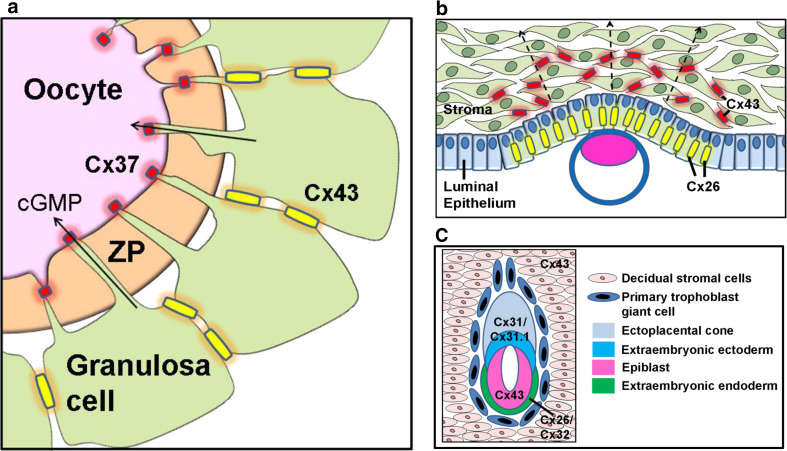Fig. 3.
a Role of gap junctions in the ovarian follicle. Cx37 and Cx43 are the predominantly expressed Cxs in mammalian follicles. Cx43 forms gap junctions (yellow) between the cumulus cells. Granulosa cells are metabolically coupled with oocytes by transzonal projections from the granulosa cell traversing the zona pellucida (ZP) and forming gap junctions at the oocyte plasma membrane (red). Animal models revealed that Cx37 forms gap junctions at the granulose cell–oocyte interface, which are responsible for the exchange of metabolites and signaling molecules, such as cyclic guanosine monophosphate, important for folliculogenesis. b Induction of gap junctions during implantation. During the receptive phase after ovulation, Cx expression and GJIC are completely repressed in the endometrium by ovarian progesterone. Upon blastocyst attachment, Cx26 expression (yellow) is locally induced in the luminal epithelium and, shortly after Cx43 expression (red), is induced in underlying stromal cells corresponding with formation of the implantation chamber. Cx43 expression further increases through the stromal compartment (arrows), characterizing its transformation into a secretory active decidua. c Connexin expression during lineage formation in the early rodent embryo. With formation of the early lineages, the expression of Cxs becomes immediately restricted to specific lineages. Whereas Cx43 is found in gap junctions throughout the epiblasts, the extraembryonic endoderm expresses Cx26 and Cx32. The proliferating diploid cells of the early trophoblast lineage express Cx31 and Cx31.1, which play critical roles in regulating trophoblast stem cell differentiation and development of the placenta

